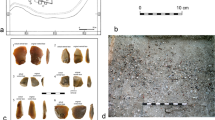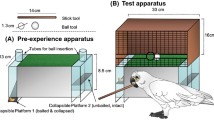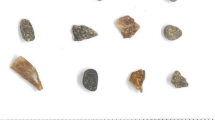Abstract
The New Caledonian crow is the only non-human animal known to craft hooked tools in the wild, but the ecological benefit of these relatively complex tools remains unknown. Here, we show that crows acquire food several times faster when using hooked rather than non-hooked tools, regardless of tool material, prey type and extraction context. This implies that small changes to tool shape can strongly affect energy-intake rates, highlighting a powerful driver for technological advancement.
This is a preview of subscription content, access via your institution
Access options
Access Nature and 54 other Nature Portfolio journals
Get Nature+, our best-value online-access subscription
$29.99 / 30 days
cancel any time
Subscribe to this journal
Receive 12 digital issues and online access to articles
$119.00 per year
only $9.92 per issue
Buy this article
- Purchase on Springer Link
- Instant access to full article PDF
Prices may be subject to local taxes which are calculated during checkout

Similar content being viewed by others
References
Hunt, G. R. Nature 379, 249–251 (1996).
Rutz, C. & St Clair, J. J. H. Behav. Processes 89, 153–165 (2012).
Hunt, G. R. & Gray, R. D. Emu 102, 349–353 (2002).
Hunt, G. R. & Gray, R. D. Proc. R. Soc. B 271, S88–S90 (2004).
St Clair, J. J. H. & Rutz, C. Phil. Trans. R. Soc. B 368, 20120415 (2013).
Klump, B. C. et al. BMC Biol. 13, 97 (2015).
Rutz, C. et al. R. Soc. Open. Sci. 3, 160439 (2016).
St Clair, J. J. H. et al. Biol. J. Linn. Soc. 118, 226–232 (2016).
Sugasawa, S. et al. Curr. Biol. 27, 3885–3890 (2017).
Boyd, R., Richerson, P. J. & Henrich, J. in Cultural Evolution: Society, Technology, Language, and Religion (eds Richerson, P. J. & Christiansen, M. H.) 119–142 (MIT Press, Cambridge, 2013).
Dean, L. G. et al. Biol. Rev. 89, 284–301 (2014).
Cheshier, J. & Kelly, R. L. Am. Antiq. 71, 353–363 (2006).
Waguespack, N. M. et al. Antiquity 83, 786–800 (2009).
Sanz, C., Call, J. & Morgan, D. Biol. Lett. 5, 293–296 (2009).
Boag, P. T. & Grant, P. R. Science 214, 82–85 (1981).
Benkman, C. W. & Lindholm, A. K. Nature 349, 519–520 (1991).
Klump, B. C. et al. Proc. R. Soc. B 282, 20150278 (2015).
Mesoudi, A. Evol. Biol. 43, 481–497 (2015).
Rutz., C. et al. Nature 537, 403–407 (2016).
Hunt, G. R. & Gray, R. D. Proc. R. Soc. B 270, 867–874 (2003).
Shumaker, R. W., Walkup, K. R. & Beck, B. B. Animal Tool Behavior: The Use and Manufacture of Tools by Animals (Johns Hopkins Univ. Press, Baltimore, 2011).
Rutz, C., Ryder, T. B. & Fleischer, R. C. Naturwissenschaften 99, 313–320 (2012).
Kenward, B. et al. Ibis 146, 652–660 (2004).
Hunt, G. R. & Gray, R. D. Biol. Lett. 3, 173–175 (2007).
Abdelkrim, J. et al. PLoS ONE 7, e36608 (2012).
Troscianko, J. & Rutz, C. Biol. Lett. 11, 20150777 (2015).
Bluff, L. A. et al. Proc. R. Soc. B 277, 1377–1385 (2010).
Therneau, T. M. coxme: Mixed Effects Cox Models. R. Package Version 2.2-5 (2012).
Crawley, M. J. The R Book (Wiley, Chichester, 2007).
Therneau, T. M. survival: Survival Analysis. R. Package Version 2.38 (2012).
Acknowledgements
We thank the Province Sud and SEM Mwe Ara, New Caledonia, for research permits and access to our study site and facilities, T. Mennesson and C. Lambert for invaluable support, S. Wischnewski, J. van der Wal, Z. Burns and several field assistants for help with bird trapping and husbandry and/or running trials, and A. Péter for technical advice on Solomon Coder software. We are grateful to J. Call, L. Dean, K. Laland, A. Magurran and L. Rendell for providing insightful and constructive comments on earlier drafts. Experiments were approved by Oxford University’s local ethical review committee before the group’s transfer to the University of St Andrews. The study was funded through a Biotechnology and Biological Sciences Research Council David Phillips Fellowship (grant BB/G023913/2 to C.R.) and PhD studentships from the Biotechnology and Biological Sciences Research Council (B.C.K.) and the Japan Student Services Organization (S.S.).
Author information
Authors and Affiliations
Contributions
J.J.H.S.C. and C.R. conceived, designed and planned the experiments. B.C.K., S.S., J.J.H.S.C. and C.R. conducted fieldwork and ran experimental trials. C.G.H. and J.J.H.S.C. scored videos, and S.S. and J.J.H.S.C. extracted data. J.J.H.S.C. and N.C. performed the statistical analyses. J.J.H.S.C. and C.R. wrote the manuscript, which was approved by all authors. C.R. secured funding and supervised the project.
Corresponding authors
Ethics declarations
Competing interests
The authors declare no competing financial interests.
Additional information
Publisher’s note: Springer Nature remains neutral with regard to jurisdictional claims in published maps and institutional affiliations.
Supplementary information
Supplementary Information
Supplementary Figure 1.
Videos
Supplementary Video 1
Hooked stick tool manufacture by a captive New Caledonian crow (sub-adult female subject HA7).
Supplementary Video 2
Probing behaviour expressed by captive New Caledonian crows (video screen), and the method of scoring using Solomon Coder software. Probing state (first column) is opened for a given hole when the tip of the tool is inserted and closed when the tool is removed. Extraction data are scored in subsequent columns. The total duration of probing required to secure the food is later summed for each hole.
Rights and permissions
About this article
Cite this article
St Clair, J.J.H., Klump, B.C., Sugasawa, S. et al. Hook innovation boosts foraging efficiency in tool-using crows. Nat Ecol Evol 2, 441–444 (2018). https://doi.org/10.1038/s41559-017-0429-7
Received:
Accepted:
Published:
Issue Date:
DOI: https://doi.org/10.1038/s41559-017-0429-7
This article is cited by
-
Monkeys who experience more feeding competition utilize social information to learn foraging skills faster
Scientific Reports (2023)
-
Oscillatory extraction behaviour suggests functional attributes of crows’ hooked-stick tools
Animal Cognition (2023)
-
Object manufacture based on a memorized template: Goffin’s cockatoos attend to different model features
Animal Cognition (2021)
-
Do wild raccoons (Procyon lotor) use tools?
Animal Cognition (2021)
-
User innovation: a novel framework for studying animal innovation within a comparative context
Animal Cognition (2019)



